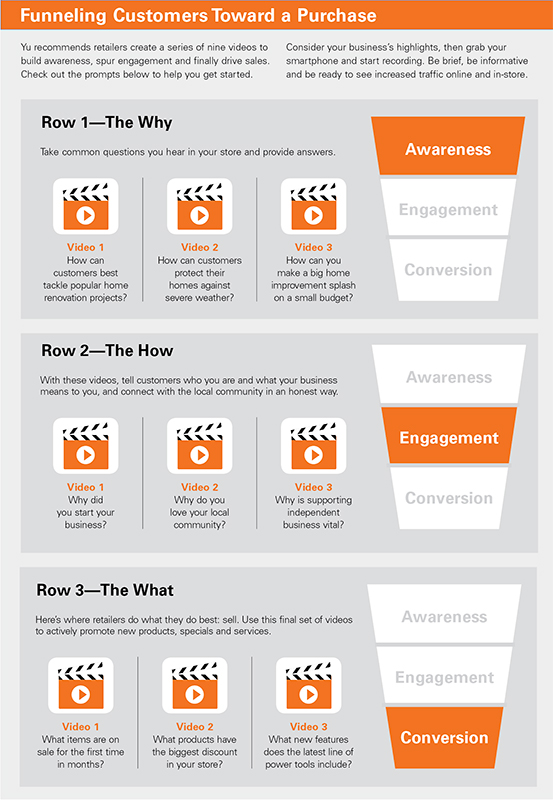Click the picture to download a PDF of this story.
Pressing Play on Your Brand
When you say your business’s name, what comes to mind? More importantly, what comes to mind for your current shoppers and potential customers?

“A brand is no longer what an ad agency says about you in a clever TV jingle,” Dennis Yu, chief technological officer of BlitzMetrics, says. “A brand is the sum of the positive and negative experiences everyone in your community has regarding your business—customers, partners and employees.”
In his role with BlitzMetrics, Yu trains students on digital best practices to manage campaigns for several high-profile clients, including the Golden State Warriors, Rosetta Stone and Nike. Yu says that today, a company’s overall brand is far more than a single ad or shopping experience.
Yu’s insights have been featured in The New York Times, The Los Angeles Times and on NPR, and he regularly contributes to AdWeek’s SocialTimes column. Yu says retailers can use Facebook—what he calls the most efficient social media platform—to build their brand, brick by brick and click by click.
Understanding Brand Basics
Yu stresses that under his definition, it’s the customer who helps define and amplify your brand.
“If you don’t provide a good experience to your customers, whether that’s at the point of sale or post-purchase, no amount of marketing is going to overcome that,” he says. “I think that’s where a lot of traditional brands are struggling. They try to crank up the ad machine when the issue is that they’re not taking care of customers. If you have a broken bone, a massage isn’t going to fix it.”
Yu recommends that retailers view every online interaction, every photo click, every like, as a way of building their brand.
“A review isn’t just going on Yelp or Google; it’s whenever they engage with you online or offline,” he says. “Whether that’s liking your latest post or telling their friends about you, those are all micro reviews that are brand-building opportunities.”
Although building your brand includes telling your story through a variety of media outlets, such as TV and in print, it also encompasses your business’s online reputation. Above all, Yu emphasizes the importance of creating unique, original video content for Facebook.
“The brands that win on Facebook are those that recognize that they have to systematically produce video. Video is no longer a side project that you hire an agency for—it’s core to marketing these days.”
Cultivating Your Brand
Yu has great news for independent retailers: They have an advantage over big boxes when it comes to building a brand on an authentic, organic level.
“Independents can be more intimate in their relationships with customers,” Yu says. “They don’t have to worry about a brand in the same way a big box does. Independents need to tell a story.”
Yu recommends that retailers stay on the lookout for teachable moments in their stores. What are your customers asking for when they visit? Yu says the answers to these questions can help retailers create a series of nine short videos that build their brand and boost their sales all while engaging customers.
“When you amplify stories of people in your town—it could be the mayor, or the local soccer team or anyone else—that’s something a national big-box retailer can’t compete against. They can’t get down to the local level and tell those stories in the same way you can,” Yu says.
Going on the Grid
Yu says that Facebook has reconfigured the algorithm it uses to display content. Now, posts from family and friends are often displayed near the top of your newsfeed as opposed to posts from business pages.
One way businesses can effectively overcome this algorithmic shift is to embed photos and videos in their posts. Facebook gives greater prominence to these kinds of posts, so Yu recommends retailers adapt accordingly and start incorporating as much multimedia content as possible to stay visible while building brand recognition. But it’s critical that retailers do this carefully and precisely.
“Most people hear about the importance of videos on Facebook, and they think they have to go live all the time,” Yu says. “It’s a lot like so many New Year’s resolutions where people go to the gym a lot but quit after a few weeks. Retailers say, ‘I tried that and it didn’t work.’ But it didn’t work because they didn’t have a plan.”
Yu recommends retailers use a 3×3 video grid to build their brand through video. (See the graphic on Page 186.) He describes the grid as nine separate 60-second videos. The first three videos focus on brand awareness, the next center on engagement and the final trio creates conversions. He says these categories also align with the “why,” “how” and “what” of your business.
According to Yu, the grid can act as a funnel that aims for sales and positive brand connotation. First, it introduces customers to your store and your employees, then encourages them to see your business as a reliable expert in the field, and finally leads them to specific products and services you offer to drive conversions.
“Eighty percent of Facebook videos are watched on smartphones,” Yu says. “No one wants to sit there for 20 or 30 minutes; people want to consume video in bite-size segments. When you sequence it in a checklist, customers can move toward the goals you’ve set.”
Yu advises retailers to be patient with their Facebook videos as they build their brand. He says many retailers only focus on the final set of videos, those which focus on the actual products and services their businesses offer, but that’s a mistake.
“You have to go through the courtship of building relationships as you build your brand,” he says. “That takes time and investment, but the good news is that it’s affordable and only takes a few minutes of your time.”
The 3×3 video grid also gives retailers a manageable data set to examine as they build their online brand. By reviewing which videos get the highest views and engagements, retailers can quickly learn which type of content resonates with their audience and adjust future videos accordingly to capitalize on that interest.

Defending Your Brand
After you’ve created videos to help consumers recognize your operation’s unique brand, Yu says the next step is entering the brand maintenance stage.
He advises retailers keep track of which videos have performed the best historically. These videos are great options for future paid Facebook promotions, which Yu says are extremely affordable. For just a few dollars, retailers can pay to boost a high-performing post that introduces new audiences to your brand
and has an established track record of success.
“The videos that perform best are like your greatest hits—they’re evergreen content that’s always applicable. It’s not like a post about a Mother’s Day sale that fades away,” Yu says.
Yu says that unlike online opportunities, traditional advertising has limitations in building your brand. Often, print ads only focus on sales and don’t give customers a true view of your individual brand. Retailers shouldn’t rely on traditional advertising alone to build brand recognition among prospective customers.
In the end, building a brand comes down to independent retailers having the patience to create engaging, unique content that consistently resonates with audiences.
“It’s like planting a seed,” Yu says. “And that doesn’t mean you have to blindly wait. You can watch the seeds grow over time.”
For more information on how videos can boost your brand, visit TheRedT.com/3×3-videos.
 Hardware Retailing The Industry's Source for Insights and Information
Hardware Retailing The Industry's Source for Insights and Information








